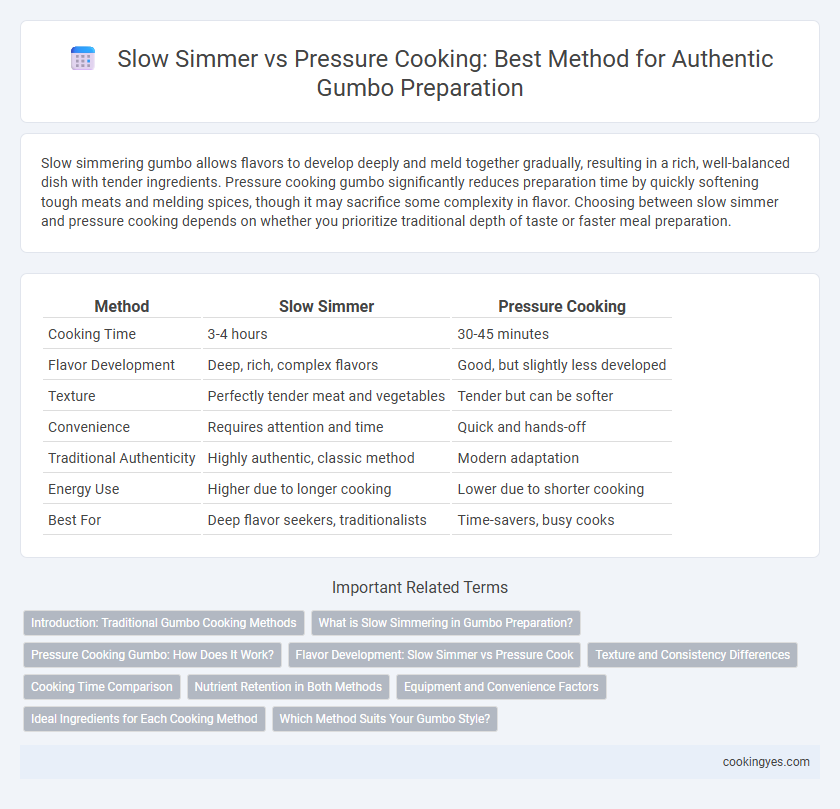Slow simmering gumbo allows flavors to develop deeply and meld together gradually, resulting in a rich, well-balanced dish with tender ingredients. Pressure cooking gumbo significantly reduces preparation time by quickly softening tough meats and melding spices, though it may sacrifice some complexity in flavor. Choosing between slow simmer and pressure cooking depends on whether you prioritize traditional depth of taste or faster meal preparation.
Table of Comparison
| Method | Slow Simmer | Pressure Cooking |
|---|---|---|
| Cooking Time | 3-4 hours | 30-45 minutes |
| Flavor Development | Deep, rich, complex flavors | Good, but slightly less developed |
| Texture | Perfectly tender meat and vegetables | Tender but can be softer |
| Convenience | Requires attention and time | Quick and hands-off |
| Traditional Authenticity | Highly authentic, classic method | Modern adaptation |
| Energy Use | Higher due to longer cooking | Lower due to shorter cooking |
| Best For | Deep flavor seekers, traditionalists | Time-savers, busy cooks |
Introduction: Traditional Gumbo Cooking Methods
Slow simmering gumbo allows flavors to meld gradually, creating a rich and complex broth characteristic of traditional Louisiana cuisine. Pressure cooking significantly reduces preparation time while maintaining the depth of spices and the tender texture of meats and seafood. Both methods emphasize the importance of developing a robust roux and integrating hearty ingredients like okra, sausage, and seafood to achieve authentic gumbo taste.
What is Slow Simmering in Gumbo Preparation?
Slow simmering in gumbo preparation involves cooking the ingredients gently over low heat for an extended period, allowing flavors to meld and develop deeply. This method enhances the gumbo's rich, complex taste and achieves tender textures in meats and vegetables without breaking down delicate ingredients. Slow simmering is essential for building the signature depth and authenticity that defines traditional gumbo recipes.
Pressure Cooking Gumbo: How Does It Work?
Pressure cooking gumbo accelerates the extraction of flavors from meat, seafood, and spices by increasing the boiling point of water through sealed high-pressure steam. This method breaks down tough ingredients quickly, infusing the roux, vegetables, and stock with rich, concentrated taste in a fraction of the traditional slow simmering time. Using a pressure cooker reduces cooking time from several hours to under an hour while maintaining the complex, layered flavors characteristic of authentic gumbo.
Flavor Development: Slow Simmer vs Pressure Cook
Slow simmering gumbo over low heat allows complex flavors to gradually meld, enhancing depth and richness through prolonged evaporation and caramelization. Pressure cooking accelerates the process, tenderizing ingredients quickly but can result in less nuanced flavor development due to reduced cooking time and limited evaporation. For authentic gumbo, slow simmering is preferred to achieve a robust and well-rounded taste profile.
Texture and Consistency Differences
Slow simmering gumbo allows flavors to meld gradually, resulting in a rich, thick broth with a velvety texture and tender, well-integrated ingredients. Pressure cooking accelerates the process, but may yield a thinner consistency and slightly less developed depth of flavor due to the rapid cooking time. The choice between methods influences the gumbo's mouthfeel, where slow simmering enhances thickness and ingredient cohesion more effectively than pressure cooking.
Cooking Time Comparison
Slow simmering gumbo typically requires 2 to 3 hours, allowing flavors to meld gradually and achieve a rich, deep taste. Pressure cooking significantly reduces this time to about 30 to 45 minutes, preserving key flavors while speeding up the process. The choice between methods depends on desired flavor development and available cooking time.
Nutrient Retention in Both Methods
Slow simmering gumbo preserves more heat-sensitive vitamins and antioxidants due to the gradual cooking process, maintaining richer nutrient profiles in vegetables and seafood. Pressure cooking accelerates tenderization but can cause nutrient degradation through high heat and reduced cooking time, particularly affecting vitamin C and some B vitamins. Both methods enhance flavors, yet slow simmering offers superior nutrient retention in gumbo preparation.
Equipment and Convenience Factors
Slow simmering gumbo on a stovetop requires a heavy-bottomed pot like a Dutch oven to ensure even heat distribution and prevent burning, offering greater control over flavor development but demanding longer cooking times and constant attention. Pressure cooking gumbo with an electric pressure cooker significantly reduces cooking time and simplifies the process, making it convenient for busy cooks, though it risks less nuanced flavor extraction and requires specialized equipment. The choice between the two depends on kitchen tools available and desired balance between convenience and flavor depth.
Ideal Ingredients for Each Cooking Method
Slow simmering gumbo allows flavors from a rich blend of sausage, okra, and the classic "holy trinity" of celery, bell pepper, and onion to develop gradually, enhancing depth with meats like chicken thighs and shrimp that benefit from gentle cooking. Pressure cooking gumbo suits quicker-cooking ingredients such as seafood and pre-cooked sausage, as the intense heat and reduced cooking time can intensify flavors but may overcook delicate vegetables like okra or leafy greens. Optimal gumbo preparation balances these methods by pairing slow simmering with robust, tougher proteins and pressure cooking with tender seafood to preserve texture and maximize taste.
Which Method Suits Your Gumbo Style?
Slow simmering preserves the rich, complex flavors of gumbo by allowing ingredients like the roux, spices, and proteins to meld over hours, ideal for traditional Creole or Cajun styles emphasizing depth and texture. Pressure cooking significantly reduces cooking time while still tenderizing tougher cuts like smoked sausage or chicken thighs, making it suitable for quick, weeknight gumbo recipes without sacrificing essential flavors. Choosing between methods depends on whether you prioritize authenticity and flavor development or convenience and speed in your gumbo preparation.
Slow simmer vs pressure cooking for gumbo preparation Infographic

 cookingyes.com
cookingyes.com